Question
Despite both sharing the same reactive data frame, why does the bar plot not match the data shown in the table in my shiny app?
Overview
I'm currently arranging the iris data frame in df - a reactive expression that uses the input of a radio button and arranges the data based on base::switch(). Afterwards, df is displayed in two forms: a bar plot and a table.
The trouble is that the bar plot doesn't respond to the radio button, while the table does. My desired output would be for the bar plot to be arranged in ascending/descending order - based on the radio button - in the same way the table is arranged.
Any clarification on why this is happening and how I can resolve this would be much appreciated!
Code
# load necessary package
library( shiny )
library( tidyverse )
# create UI
ui <- fluidPage(
title = "Reactive Programming"
, plotOutput( outputId = "my.barplot" )
, radioButtons( inputId = "direction"
, label = "Arrange the data:"
, choices = c("Ascending", "Descending")
, selected = "Descending"
, inline = TRUE )
, tableOutput( outputId = "my.table" )
)
# create server
server <- function( input, output, session){
# arrange iris in ascending/descending order based on the "Sepal.Length" column
df <- reactive({
switch( EXPR = input$direction
, "Ascending" = iris %>% arrange( Sepal.Length )
, "Descending" = iris %>% arrange( desc( Sepal.Length ) ) )
})
# plot df()
output$my.barplot <- renderPlot({
ggplot( data = df() ) +
geom_bar( aes( x = Species
, y = Sepal.Length )
, stat = "identity" )
})
# show df()
output$my.table <- renderTable({
df()
})
}
# run App
shinyApp( ui = ui, server = server )
# end of script #
Session Info
R version 3.4.4 (2018-03-15)
Platform: x86_64-apple-darwin15.6.0 (64-bit)
Running under: macOS High Sierra 10.13.2
Matrix products: default
BLAS: /System/Library/Frameworks/Accelerate.framework/Versions/A/Frameworks/vecLib.framework/Versions/A/libBLAS.dylib
LAPACK: /Library/Frameworks/R.framework/Versions/3.4/Resources/lib/libRlapack.dylib
locale:
[1] en_US.UTF-8/en_US.UTF-8/en_US.UTF-8/C/en_US.UTF-8/en_US.UTF-8
attached base packages:
[1] stats graphics grDevices utils datasets methods base
other attached packages:
[1] forcats_0.3.0 stringr_1.3.0 dplyr_0.7.4 purrr_0.2.4 readr_1.1.1
[6] tidyr_0.8.0 tibble_1.4.2 ggplot2_2.2.1 tidyverse_1.2.1 shiny_1.0.5
loaded via a namespace (and not attached):
[1] Rcpp_0.12.16 cellranger_1.1.0 pillar_1.2.1 compiler_3.4.4
[5] plyr_1.8.4 bindr_0.1.1 tools_3.4.4 digest_0.6.15
[9] lubridate_1.7.3 jsonlite_1.5 nlme_3.1-131.1 gtable_0.2.0
[13] lattice_0.20-35 pkgconfig_2.0.1 rlang_0.2.0 psych_1.7.8
[17] cli_1.0.0 rstudioapi_0.7 yaml_2.1.18 parallel_3.4.4
[21] haven_1.1.1 bindrcpp_0.2 xml2_1.2.0 httr_1.3.1
[25] hms_0.4.2 grid_3.4.4 glue_1.2.0 R6_2.2.2
[29] readxl_1.0.0 foreign_0.8-69 modelr_0.1.1 reshape2_1.4.3
[33] magrittr_1.5 scales_0.5.0 htmltools_0.3.6 rvest_0.3.2
[37] assertthat_0.2.0 mnormt_1.5-5 colorspace_1.3-2 mime_0.5
[41] xtable_1.8-2 httpuv_1.3.6.2 stringi_1.1.7 lazyeval_0.2.1
[45] munsell_0.4.3 broom_0.4.3 crayon_1.3.4


